The xenon isotopic signature of the mantle beneath Massif Central
Affiliations | Corresponding Author | Cite as | Funding information- Share this article





Article views:4,269Cumulative count of HTML views and PDF downloads.
- Download Citation
- Rights & Permissions
top
Abstract
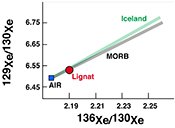
Figures and Tables
 Figure 1 Three-neon isotope diagram. MORB data are from Moreira et al. (1998) and define the MORB-AIR mixing line (Sarda et al., 1988), which has a different slope than the OIB mixing lines (Honda et al., 1991; Moreira et al., 2001). The OIB mixing lines are from Mukhopadhyay (2012) and Peron et al. (2016). The MORB source has a 20Ne/22Ne ~12.5. The neon in Lignat spring comes from the mixture of mantle-derived (~12 %) and atmospheric neon (~88 %). Data from the Eifel area are also reported (Brauer et al., 2013). | 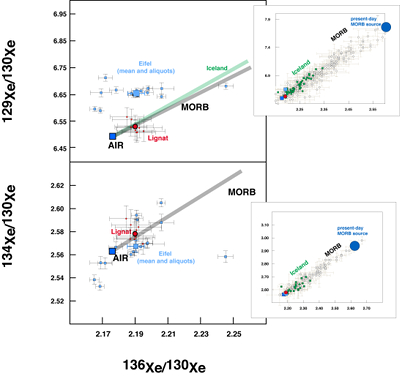 Figure 2 Xenon isotopes in the Lignat gas (aliquots: small red dots; mean: large red dot), compared to MORB (Kunz et al., 1998; Parai et al., 2012; Tucker et al., 2012) and Iceland basalts (Mukhopadhyay, 2012). The Eifel gas is shown for comparison (small blue squares: aliquots, large blue square: mean) (Caracausi et al., 2016). The inserts represent the global scale of variation in mantle-derived samples. | 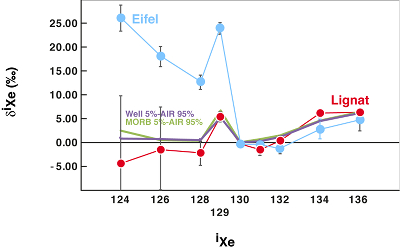 Figure 3 Xenon isotopic ratios in the Lignat gas expressed in ‰ deviation relative to the atmospheric composition. Assuming the xenon composition reflects mixing between air and MORB (or CO2-well gas; Holland and Ballentine, 2006), one can estimate the proportion of atmospheric xenon. Using the 136Xe/130Xe ratio, 95 % of the 130Xe in the Lignat source is sourced from the air. The other isotopic ratios can be estimated using this mixing proportion. Two patterns are given for the result of this mixing: violet using CO2-well gas and green using the mean MORB-source ratios (Table S-2). The Lignat gas satisfies a simple binary mixture between air and MORB. Although the Eifel gas (blue circles) shows the same pattern for fissiogenic isotopes, it exhibits notable excesses in light Xe isotopes that are unaccounted for by the MORB-AIR mixing model. |
| Figure 1 | Figure 2 | Figure 3 |
top
Introduction
Noble gases are excellent records of interactions between the mantle and the atmosphere over geological history, and provide important information on the origin and evolution of volatiles on Earth. Helium and neon are clear markers of the layered structure of the mantle, because their isotopic ratios are less radiogenic in most Oceanic Island Basalts (OIB) than in Mid Ocean Ridge Basalts (MORB), which is interpreted as reflecting the existence of a deep undegassed mantle, the source of mantle plumes (Kurz et al., 1982
Kurz, M.D., Jenkins, W.J., Hart, S.R. (1982) Helium isotopic systematics of oceanic islands and mantle heterogeneity. Nature 297, 43-47.
; Honda et al., 1991Honda, M., McDougall, I., Patterson, D.B., Doulgeris, A., Clague, D. (1991) Possible solar noble-gas component in Hawaiian basalts. Nature 349, 149-151.
; Moreira and Allègre, 1998Moreira, M., Allègre, C.J. (1998) Helium - Neon systematics and the structure of the mantle. Chemical Geology 147, 53-59.
). Xenon in oceanic basalts also places strong constraints on the degassing history of the mantle and on the origin and evolution of volatiles (Ozima et al., 1985Ozima, M., Podozek, F.A., Igarashi, G. (1985) Terrestrial xenon isotope constraints on the early history of the Earth. Nature 315, 471-474.
; Kunz et al., 1998Kunz, J., Staudacher, T., Allègre, C.J. (1998) Plutonium-Fission Xenon Found in Earth's Mantle. Science 280, 877-880.
; Mukhopadhyay, 2012Mukhopadhyay, S. (2012) Early differentiation and volatile accretion recorded in deep mantle Neon and Xenon. Nature 486, 101-104.
). Radiogenic/fissiogenic isotopic ratios (129, 131-136Xe/130Xe) are well constrained in the sources of MORB and OIB using neon as a proxy for the degree of contamination by air (Moreira et al., 1998Moreira, M., Kunz, J., Allègre, C.J. (1998) Rare gas systematics on popping rock : estimates of isotopic and elemental compositions in the upper mantle. Science 279, 1178-1181.
; Mukhopadhyay, 2012Mukhopadhyay, S. (2012) Early differentiation and volatile accretion recorded in deep mantle Neon and Xenon. Nature 486, 101-104.
). However, due to their low abundances, non-radiogenic isotopes (124-128, 130Xe) are difficult to analyse, and hence only a few gas-rich samples, such as CO2-well gases, can be accurately measured. These samples therefore provide fundamental constraints on the origin and evolution of terrestrial noble gases (Caffee et al., 1999Caffee, M.W., Hudson, G.P., Velsko, C., Huss, G.R., Alexander, E.C., Chivas, R. (1999) Primordial noble gases from earth's mantle: identification of primitive volatile component. Science 285, 2115-2118.
; Holland and Ballentine, 2006Holland, G., Ballentine, C.J. (2006) Seawater subduction controls the heavy noble gas composition of the mantle. Nature 441, 186-191.
). Existing evidence shows that the primitive mantle had a chondritic xenon isotope composition (Holland and Ballentine, 2006Holland, G., Ballentine, C.J. (2006) Seawater subduction controls the heavy noble gas composition of the mantle. Nature 441, 186-191.
; Holland et al., 2009Holland, G., Cassidy, M., Ballentine, C.J. (2009) Meteorite Kr in Earth’s Mantle Suggests a Late Accretionary Source for the Atmosphere. Science 326, 1522-1525.
), and that the xenon of the Hadean atmosphere was a mixture of chondritic and cometary xenon (Marty et al., 2017Marty, B., Altwegg, K., Balsiger, H., Bar-Nun, A., Bekaert, D.V., Berthelier, J.J., Bieler, A., Briois, C., Calmonte, U., Combi, M., et al. (2017) Xenon isotopes in 67P/Churyumov-Gerasimenko show that comets contributed to Earth's atmosphere. Science 356, 1069-1072.
). Since the Hadean, the atmosphere has progressively lost Xe, such that <10 % remains today. The physical mechanism for such loss is unknown, however it has caused considerable isotopic fractionation and resulted in the present-day atmospheric isotopic composition (Pujol et al., 2011Pujol, M., Marty, B., Burgess, R. (2011) Chondritic-like xenon trapped in Archean rocks: A possible signature of the ancient atmosphere. Earth and Planetary Science Letters 308, 298-306.
). Furthermore, subduction of atmospheric xenon has modified the non-radiogenic xenon isotopic ratios of the mantle from a chondritic ratio down to the present-day mantle composition (Holland and Ballentine, 2006Holland, G., Ballentine, C.J. (2006) Seawater subduction controls the heavy noble gas composition of the mantle. Nature 441, 186-191.
).If subduction of atmospheric xenon is possible, then the homogeneity of the xenon isotopic composition in different mantle sources is an enigma. One might expect significant variations in all xenon isotopic ratios. However, xenon analysis in oceanic basalts remains difficult because of its low abundance, in addition to the presence of a ubiquitous atmospheric contaminant that masks the mantle signature (Ballentine and Barfod, 2000
Ballentine, C., Barfod, D. (2000) The origin of air-like noble gases in MORB and OIB. Earth and Planetary Science Letters 180, 39-48.
). In order to circumvent this difficulty, gases from thermal springs, where CO2 degasses naturally, are analysed, as they carry also mantle-derived noble gases. Indeed, mantle-derived noble gas signatures are observed at Victoriaquelle in the Eifel volcanic region, Germany (Brauer et al., 2013Brauer, K., Kampf, H., Niedermann, S., Strauch, G. (2013) Indications for the existence of different magmatic reservoirs beneath the Eifel area (Germany): A multi-isotope (C, N, He, Ne, Ar) approach. Chemical Geology 356, 193-208.
). Recently, this spring has been studied for xenon, providing constraints on the xenon composition of the mantle and on the nature of volcanism in the Eifel region (Caracausi et al., 2016Caracausi, A., Avice, G., Burnard, P., Furi, E., Marty, B. (2016) Chondritic xenon in the Earth’s mantle. Nature 533, 82-85.
). Interestingly, the authors observed a xenon signature that does not fall on the MORB-OIB line in the 129Xe/130Xe-136Xe/130Xe diagram, although the He and Ne clearly have signatures consistent with their derivation from MORB- or Sub Continental Lithospheric Mantle (SCLM)-sources (Brauer et al., 2013Brauer, K., Kampf, H., Niedermann, S., Strauch, G. (2013) Indications for the existence of different magmatic reservoirs beneath the Eifel area (Germany): A multi-isotope (C, N, He, Ne, Ar) approach. Chemical Geology 356, 193-208.
). More surprisingly, they report 124-128Xe anomalies for a sample with more than 90 % atmospheric contamination, which is interpreted as reflecting the chondritic signature of the Eifel mantle source for these isotopes. In order to determine whether this is a widespread feature of the European mantle or whether it is specific to the Eifel region, we have analysed the isotopic ratios of each of the noble gases in the Lignat thermal spring, Massif Central. The Massif Central, like the Eifel, belongs to the Central European Volcanic Province (CEVP), in which the cause of volcanism is a matter of debate. Several scenarios have been proposed to account for the widespread volcanism in the region: an asthenospheric upwelling resulting from the formation of a deep lithospheric root under the Alps (Merle and Michon, 2001Merle, O., Michon, L. (2001) The formation of the west European rift: A new model as exemplified by the Massif Central aera. Bulletin de la Societé Géologique de France 72, 213-221.
), the melting of the Sub-Continental Lithospheric Mantle (SCLM) (Gautheron et al., 2005Gautheron, C., Moreira, M., Allegre, C.J. (2005) He, Ne and Ar composition of the European lithospheric mantle. Chemical Geology 217, 97-112.
) or a deep-seated mantle plume (e.g., Buikin et al., 2005Buikin, A.I., Trieloff, M., Hopp, J., Althaus, T., Korochantseva, E.V., Schwarz, J.P., Altherr, R. (2005) Noble gas isotopes suggest deep mantle plume source of late Cenozoic mafic alkaline volcanism in Europe. Earth and Planetary Science Letters 230, 143-162.
). Our results show that noble gases have signatures consistent with those expected from a mantle source similar to that of MORB, obviating the need for a deep mantle plume.top
Sample Location, Sampling, Analytical Procedure and Results
The Lignat spring (“La Gargouillère”) is located in the Massif Central, ~15 km from Clermont Ferrand, France (45°42'23" N, 3°15'42" E). This source was selected because of its vigorous eruptive activity that liberates pure CO2. The gas was collected in January 2017 in a 5 litre stainless-steel reservoir. The gas was analysed at IFPEN for abundances of major gases and noble gases. It contains 100 % CO2, 38 ppm helium, 6 ppb neon, 53 ppm argon and 0.8 ppb xenon. The CO2 δ13C is -3.6 ‰ and the CO2/3He is 3.7 x 109. Noble gas isotopic compositions were analysed at IPGP following the analytical procedure described in the Supplementary Information.
Results for the Lignat gas are given in Tables S-1 and S-2. In the discussion that follows, the mean compositions of the aliquots are used. The 3He/4He ratio is 5.51 ± 0.03 Ra (1σ) (Ra is the atmospheric ratio = 1.384 x 10-6). The 20Ne/22Ne and 21Ne/22Ne isotopic ratios are 10.118 ± 0.009 and 0.03297 ± 0.00005, respectively (air: 9.8 and 0.0290). In the three-neon isotope diagram, the Lignat gas falls on the MORB line (Fig. 1). The 38Ar/36Ar ratio is atmospheric (0.18833 ± 0.00015), within uncertainty. The 40Ar/36Ar ratio is higher (1113 ± 3) than the atmospheric ratio (295.5). Krypton isotopes are not reported because all measured isotopic ratios are atmospheric within uncertainty. Xenon isotopes are given in Table S-2. The 129Xe/130Xe, 134Xe/130Xe and 136Xe/130Xe isotopic ratios of the Lignat gas are reported in Figure 2 and compared with those of MORB (Kunz et al., 1998
Kunz, J., Staudacher, T., Allègre, C.J. (1998) Plutonium-Fission Xenon Found in Earth's Mantle. Science 280, 877-880.
; Parai et al., 2012Parai, R., Mukhopadhyay, S., Standish, J.J. (2012) Heterogeneous upper mantle Ne,Ar and Xe isotopic compositions and a possible Dupal noble gas signature recorded in basalts from the Southwest Indian Ridge. Earth and Planetary Science Letters 359-360, 227-239.
; Tucker et al., 2012Tucker, J.M., Mukhopadhyay, S., Schilling, J.-G. (2012) The heavy noble gas composition of the depleted MORB mantle (DMM) and its implications for the preservation of heterogeneities in the mantle. Earth and Planetary Science Letters 355-356, 244-254.
), Iceland (Mukhopadhyay, 2012Mukhopadhyay, S. (2012) Early differentiation and volatile accretion recorded in deep mantle Neon and Xenon. Nature 486, 101-104.
) and Eifel (Caracausi et al., 2016Caracausi, A., Avice, G., Burnard, P., Furi, E., Marty, B. (2016) Chondritic xenon in the Earth’s mantle. Nature 533, 82-85.
). Although the excesses are small, the gas contains a detectable contribution of mantle-derived xenon. The Lignat gas falls on the MORB/Iceland line and is clearly different from the Eifel gas value in a 129Xe/130Xe - 136Xe/130Xe diagram. The non-radiogenic isotopic ratios 124Xe/130Xe, 126Xe/130Xe and 128Xe/130Xe are atmospheric within uncertainty.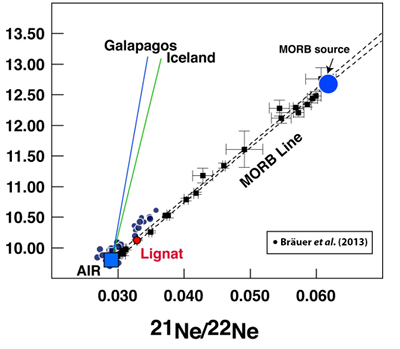
Figure 1 Three-neon isotope diagram. MORB data are from Moreira et al. (1998)
Moreira, M., Kunz, J., Allègre, C.J. (1998) Rare gas systematics on popping rock : estimates of isotopic and elemental compositions in the upper mantle. Science 279, 1178-1181.
and define the MORB-AIR mixing line (Sarda et al., 1988Sarda, P., Staudacher, T., Allègre, C.J. (1988) Neon isotopes in submarine basalts. Earth and Planetary Science Letters 91, 73-88.
), which has a different slope than the OIB mixing lines (Honda et al., 1991Honda, M., McDougall, I., Patterson, D.B., Doulgeris, A., Clague, D. (1991) Possible solar noble-gas component in Hawaiian basalts. Nature 349, 149-151.
; Moreira et al., 2001Moreira, M., Breddam, K., Curtice, J., Kurz, M. (2001) Solar neon in the Icelandic mantle: evidence for an undegassed lower mantle. Earth and Planetary Science Letters 185.
). The OIB mixing lines are from Mukhopadhyay (2012)Mukhopadhyay, S. (2012) Early differentiation and volatile accretion recorded in deep mantle Neon and Xenon. Nature 486, 101-104.
and Peron et al. (2016)Peron, S., Moreira, M., Colin, A., Arbaret, L., Putlitz, B., Kurz, M.D. (2016) Neon isotopic composition of the mantle constrained by single vesicles analyses. Earth and Planetary Science Letters 449, 145–154.
. The MORB source has a 20Ne/22Ne ~12.5. The neon in Lignat spring comes from the mixture of mantle-derived (~12 %) and atmospheric neon (~88 %). Data from the Eifel area are also reported (Brauer et al., 2013Brauer, K., Kampf, H., Niedermann, S., Strauch, G. (2013) Indications for the existence of different magmatic reservoirs beneath the Eifel area (Germany): A multi-isotope (C, N, He, Ne, Ar) approach. Chemical Geology 356, 193-208.
).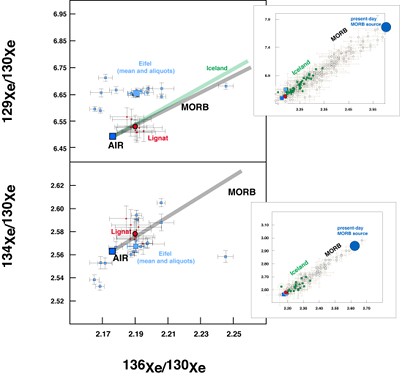
Figure 2 Xenon isotopes in the Lignat gas (aliquots: small red dots; mean: large red dot), compared to MORB (Kunz et al., 1998
Kunz, J., Staudacher, T., Allègre, C.J. (1998) Plutonium-Fission Xenon Found in Earth's Mantle. Science 280, 877-880.
; Parai et al., 2012Parai, R., Mukhopadhyay, S., Standish, J.J. (2012) Heterogeneous upper mantle Ne,Ar and Xe isotopic compositions and a possible Dupal noble gas signature recorded in basalts from the Southwest Indian Ridge. Earth and Planetary Science Letters 359-360, 227-239.
; Tucker et al., 2012Tucker, J.M., Mukhopadhyay, S., Schilling, J.-G. (2012) The heavy noble gas composition of the depleted MORB mantle (DMM) and its implications for the preservation of heterogeneities in the mantle. Earth and Planetary Science Letters 355-356, 244-254.
) and Iceland basalts (Mukhopadhyay, 2012Mukhopadhyay, S. (2012) Early differentiation and volatile accretion recorded in deep mantle Neon and Xenon. Nature 486, 101-104.
). The Eifel gas is shown for comparison (small blue squares: aliquots, large blue square: mean) (Caracausi et al., 2016Caracausi, A., Avice, G., Burnard, P., Furi, E., Marty, B. (2016) Chondritic xenon in the Earth’s mantle. Nature 533, 82-85.
). The inserts represent the global scale of variation in mantle-derived samples.top
Discussion
Helium, neon, 40Ar/36Ar and 129-136Xe/130Xe isotopic ratios suggest the contribution of mantle-derived gas in the Lignat spring, consistent with the CO2/3He and δ13C values measured. Helium is more radiogenic than the mean MORB ratio of 8 ± 1 Ra (Allègre et al., 1995
Allègre, C.J., Moreira, M., Staudacher, T. (1995) 4He/3He dispersion and mantle convection. Geophysical Research Letters 22, 2325-2328.
), and within uncertainty of the mean SCLM ratio of 6.1 ± 0.9 Ra (Gautheron and Moreira, 2002Gautheron, C., Moreira, M. (2002) Helium signature of the subcontinental lithospheric mantle. Earth and Planetary Science Letters 199, 39-47.
). Neon isotopes suggest a simple binary mixing between air/water and a MORB-like derived gas. A simple calculation indicates that ~12 % of the neon is derived from the mantle, assuming a 20Ne/22Ne for the MORB source of 12.5 (Ballentine, 1997Ballentine, C.J. (1997) Resolving the mantle He/Ne and crustal 21Ne/ 22Ne in well gases. Earth and Planetary Science Letters 152, 233-250.
; Moreira et al., 1998Moreira, M., Kunz, J., Allègre, C.J. (1998) Rare gas systematics on popping rock : estimates of isotopic and elemental compositions in the upper mantle. Science 279, 1178-1181.
). Xenon isotope systematics also suggest binary mixing between air and a MORB-like gas. However, because MORB and OIB fall on the same mixing line, a plume-like contribution cannot be excluded based on xenon alone. Nevertheless, the neon isotope systematics, which are sensitive to the contribution of primitive mantle (Moreira and Allègre, 1998Moreira, M., Allègre, C.J. (1998) Helium - Neon systematics and the structure of the mantle. Chemical Geology 147, 53-59.
; Hopp et al., 2004Hopp, J., Trieloff, M., Altherr, R. (2004) Neon isotopes in mantle rocks from the Red Sea region reveal large-scale plume-lithosphere interaction. Earth and Planetary Science Letters 219, 61-76.
), appear to preclude the contribution of deep mantle material in the source of the Lignat spring. Trends of simple binary mixing between atmospheric- and mantle-derived Xe are illustrated in Figure 3. Here, the isotopic composition of the mixture between 5 % of a MORB-like gas and 95 % of an atmospheric gas is shown. The MORB signature is estimated using both MORB data from Kunz et al. (1998)Kunz, J., Staudacher, T., Allègre, C.J. (1998) Plutonium-Fission Xenon Found in Earth's Mantle. Science 280, 877-880.
and CO2-well gases by Holland and Ballentine (2006)Holland, G., Ballentine, C.J. (2006) Seawater subduction controls the heavy noble gas composition of the mantle. Nature 441, 186-191.
. The final composition is insensitive to this choice, as both calculated compositions are similar (Table S-2; Fig. 3). On the basis of this model, the Xe isotope composition of Lignat spring can be satisfactorily explained by binary mixing. It also accounts for the absence of any 124-128Xe excesses in the spring. In detail, because the gas contains ~95 % air-derived xenon, this atmospheric contribution completely masks the present-day mantle composition for these isotopes, which could not be chondritic because the mantle was “contaminated” by subducted atmospheric xenon (Holland and Ballentine, 2006Holland, G., Ballentine, C.J. (2006) Seawater subduction controls the heavy noble gas composition of the mantle. Nature 441, 186-191.
).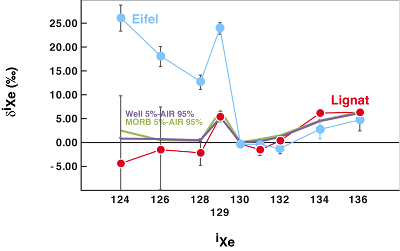
Figure 3 Xenon isotopic ratios in the Lignat gas expressed in ‰ deviation relative to the atmospheric composition. Assuming the xenon composition reflects mixing between air and MORB (or CO2-well gas; Holland and Ballentine, 2006
Holland, G., Ballentine, C.J. (2006) Seawater subduction controls the heavy noble gas composition of the mantle. Nature 441, 186-191.
), one can estimate the proportion of atmospheric xenon. Using the 136Xe/130Xe ratio, 95 % of the 130Xe in the Lignat source is sourced from the air. The other isotopic ratios can be estimated using this mixing proportion. Two patterns are given for the result of this mixing: violet using CO2-well gas and green using the mean MORB-source ratios (Table S-2). The Lignat gas satisfies a simple binary mixture between air and MORB. Although the Eifel gas (blue circles) shows the same pattern for fissiogenic isotopes, it exhibits notable excesses in light Xe isotopes that are unaccounted for by the MORB-AIR mixing model.The 131-136Xe/130Xe isotopic signature of gases from the Eifel region determined by Caracausi et al. (2016)
Caracausi, A., Avice, G., Burnard, P., Furi, E., Marty, B. (2016) Chondritic xenon in the Earth’s mantle. Nature 533, 82-85.
is identical to that of the Lignat gas (Fig. 3). However, the cause of excesses in 124-129Xe isotopes in the Eifel springs remains unclear. The significant air contribution (95 %) needed to explain the heavy xenon isotopic compositions in both gases should not produce a detectable excess of non-radiogenic isotopes when using the observed present-day mantle composition. Even if the present-day mantle had a chondritic composition in these isotopes, given 95 % contamination by air, then an excess of only 3 ‰ should be observed for the 128Xe/130Xe ratio, rather than the 15–25 ‰ reported by Caracausi et al. (2016)Caracausi, A., Avice, G., Burnard, P., Furi, E., Marty, B. (2016) Chondritic xenon in the Earth’s mantle. Nature 533, 82-85.
. Moreover, a mantle source with a solely chondritic non-radiogenic xenon isotope composition for has not been observed in mantle-derived samples. Certainly, in MORB or CO2-well gas sources, there is no hint of such a signature (Kunz et al., 1998Kunz, J., Staudacher, T., Allègre, C.J. (1998) Plutonium-Fission Xenon Found in Earth's Mantle. Science 280, 877-880.
; Holland and Ballentine, 2006Holland, G., Ballentine, C.J. (2006) Seawater subduction controls the heavy noble gas composition of the mantle. Nature 441, 186-191.
), and the same is true for OIB. The 128Xe/130Xe ratios measured in Iceland basalts are close to the atmospheric value, and are distinct from chondritic 128Xe/130Xe value in high 20Ne/22Ne and 129Xe/130Xe crushing steps (Mukhopadhyay, 2012Mukhopadhyay, S. (2012) Early differentiation and volatile accretion recorded in deep mantle Neon and Xenon. Nature 486, 101-104.
).Based on our study, a plume origin is not required to cause the volcanism observed in the Massif Central. By contrast, a plume scenario is still permissible in the Eifel region. Based on neon isotopes measured on xenoliths, Buikin et al. (2005)
Buikin, A.I., Trieloff, M., Hopp, J., Althaus, T., Korochantseva, E.V., Schwarz, J.P., Altherr, R. (2005) Noble gas isotopes suggest deep mantle plume source of late Cenozoic mafic alkaline volcanism in Europe. Earth and Planetary Science Letters 230, 143-162.
suggest that there is a mantle plume contributing to the European intraplate magmatism, an interpretation challenged by other authors who argue that the source was restricted to the upper mantle (Gautheron et al., 2005Gautheron, C., Moreira, M., Allegre, C.J. (2005) He, Ne and Ar composition of the European lithospheric mantle. Chemical Geology 217, 97-112.
; Brauer et al., 2013Brauer, K., Kampf, H., Niedermann, S., Strauch, G. (2013) Indications for the existence of different magmatic reservoirs beneath the Eifel area (Germany): A multi-isotope (C, N, He, Ne, Ar) approach. Chemical Geology 356, 193-208.
). A deep mantle plume origin was also suggested based on xenon isotopes by Caracausi et al. (2016)Caracausi, A., Avice, G., Burnard, P., Furi, E., Marty, B. (2016) Chondritic xenon in the Earth’s mantle. Nature 533, 82-85.
on the basis of the 129Xe/136Xe ratio, which appears to be close to that of Icelandic basalts (Mukhopadhyay, 2012Mukhopadhyay, S. (2012) Early differentiation and volatile accretion recorded in deep mantle Neon and Xenon. Nature 486, 101-104.
). However, for the aforementioned reasons, other explanations are required to account for the high 124-129Xe/130Xe ratios in these air-contaminated gases (Fig. 3). For the Eifel, a simple MORB-AIR mixing scenario would not be able to satisfy both the 131-136Xe/130Xe, He, Ne isotopic ratios and the 124-129Xe/130Xe ratios. A deep mantle plume origin for the volcanism in Eifel therefore remains questionable and further work is clearly required to understand the signatures observed in springs in both the Massif Central and the Eifel.top
Conclusions
We have analysed noble gases in the Lignat thermal spring (Massif Central) in order to characterise the noble gas isotopic composition of the mantle under the CEVP. The sample shows extensive atmospheric contamination, but measurable mantle-derived noble gases. The 3He/4He ratio is 5.51 ± 0.03 Ra. The neon isotopic composition falls exactly on the MORB line in the three-neon isotope diagram. The 124-128Xe/130Xe ratios are atmospheric within uncertainties whereas 129-136Xe/130Xe ratios show evidence for the contribution of a typical MORB signature, in agreement with the neon isotope systematics. The isotopic spectrum of xenon is well explained by a mixture between atmospheric and present-day MORB-source xenon. The mantle under Massif Central thus appears distinct from the mantle beneath Eifel.
top
Acknowledgements
We thank the three reviewers for their constructive comments on the manuscript. M.M. acknowledges the Labex UnivEarthS for its financial support (IPGP # 3914).
Editor: Bruce Watson
top
References
Allègre, C.J., Moreira, M., Staudacher, T. (1995) 4He/3He dispersion and mantle convection. Geophysical Research Letters 22, 2325-2328.
 Show in context
Show in context Helium is more radiogenic than the mean MORB ratio of 8 ± 1 Ra (Allègre et al., 1995), and within uncertainty of the mean SCLM ratio of 6.1 ± 0.9 Ra (Gautheron and Moreira, 2002).
View in article
Ballentine, C.J. (1997) Resolving the mantle He/Ne and crustal 21Ne/ 22Ne in well gases. Earth and Planetary Science Letters 152, 233-250.
 Show in context
Show in contextA simple calculation indicates that ~12 % of the neon is derived from the mantle, assuming a 20Ne/22Ne for the MORB source of 12.5 (Ballentine, 1997; Moreira et al., 1998).
View in article
Ballentine, C., Barfod, D. (2000) The origin of air-like noble gases in MORB and OIB. Earth and Planetary Science Letters 180, 39-48.
 Show in context
Show in contextHowever, xenon analysis in oceanic basalts remains difficult because of its low abundance, in addition to the presence of a ubiquitous atmospheric contaminant that masks the mantle signature (Ballentine and Barfod, 2000).
View in article
Brauer, K., Kampf, H., Niedermann, S., Strauch, G. (2013) Indications for the existence of different magmatic reservoirs beneath the Eifel area (Germany): A multi-isotope (C, N, He, Ne, Ar) approach. Chemical Geology 356, 193-208.
 Show in context
Show in context Indeed, mantle-derived noble gas signatures are observed at Victoriaquelle in the Eifel volcanic region, Germany (Brauer et al., 2013).
View in article
Interestingly, the authors observed a xenon signature that does not fall on the MORB-OIB line in the 129Xe/130Xe-136Xe/130Xe diagram, although the He and Ne clearly have signatures consistent with their derivation from MORB- or Sub Continental Lithospheric Mantle (SCLM)-sources (Brauer et al., 2013).
View in article
Figure 1 [...] Data from the Eifel area are also reported (Brauer et al., 2013).
View in article
Based on neon isotopes measured on xenoliths, Buikin et al. (2005) suggest that there is a mantle plume contributing to the European intraplate magmatism, an interpretation challenged by other authors who argue that the source was restricted to the upper mantle (Gautheron et al., 2005; Brauer et al., 2013).
View in article
Buikin, A.I., Trieloff, M., Hopp, J., Althaus, T., Korochantseva, E.V., Schwarz, J.P., Altherr, R. (2005) Noble gas isotopes suggest deep mantle plume source of late Cenozoic mafic alkaline volcanism in Europe. Earth and Planetary Science Letters 230, 143-162.
 Show in context
Show in context Several scenarios have been proposed to account for the widespread volcanism in the region: an asthenospheric upwelling resulting from the formation of a deep lithospheric root under the Alps (Merle and Michon, 2001), the melting of the Sub-Continental Lithospheric Mantle (SCLM) (Gautheron et al., 2005) or a deep-seated mantle plume (e.g., Buikin et al., 2005).
View in article
Based on neon isotopes measured on xenoliths, Buikin et al. (2005) suggest that there is a mantle plume contributing to the European intraplate magmatism, an interpretation challenged by other authors who argue that the source was restricted to the upper mantle (Gautheron et al., 2005; Brauer et al., 2013).
View in article
Caffee, M.W., Hudson, G.P., Velsko, C., Huss, G.R., Alexander, E.C., Chivas, R. (1999) Primordial noble gases from earth's mantle: identification of primitive volatile component. Science 285, 2115-2118.
 Show in context
Show in context These samples therefore provide fundamental constraints on the origin and evolution of terrestrial noble gases (Caffee et al., 1999; Holland and Ballentine, 2006).
View in article
Caracausi, A., Avice, G., Burnard, P., Furi, E., Marty, B. (2016) Chondritic xenon in the Earth’s mantle. Nature 533, 82-85.
 Show in context
Show in contextRecently, this spring has been studied for xenon, providing constraints on the xenon composition of the mantle and on the nature of volcanism in the Eifel region (Caracausi et al., 2016).
View in article
The 129Xe/130Xe, 134Xe/130Xe and 136Xe/130Xe isotopic ratios of the Lignat gas are reported in Figure 2 and compared with those of MORB (Kunz et al., 1998; Parai et al., 2012; Tucker et al., 2012), Iceland (Mukhopadhyay, 2012) and Eifel (Caracausi et al., 2016).
View in article
Figure 2 [...] The Eifel gas is shown for comparison (small blue squares: aliquots, large blue square: mean) (Caracausi et al., 2016).
View in article
The 131-136Xe/130Xe isotopic signature of gases from the Eifel region determined by Caracausi et al. (2016) is identical to that of the Lignat gas (Fig. 3).
View in article
Even if the present-day mantle had a chondritic composition in these isotopes, given 95 % contamination by air, then an excess of only 3 ‰ should be observed for the 128Xe/130Xe ratio, rather than the 15–25 ‰ reported by Caracausi et al. (2016).
View in article
A deep mantle plume origin was also suggested based on xenon isotopes by Caracausi et al. (2016) on the basis of the 129Xe/136Xe ratio, which appears to be close to that of Icelandic basalts (Mukhopadhyay, 2012).
View in article
Gautheron, C., Moreira, M. (2002) Helium signature of the subcontinental lithospheric mantle. Earth and Planetary Science Letters 199, 39-47.
 Show in context
Show in contextHelium is more radiogenic than the mean MORB ratio of 8 ± 1 Ra (Allègre et al., 1995), and within uncertainty of the mean SCLM ratio of 6.1 ± 0.9 Ra (Gautheron and Moreira, 2002).
View in article
Gautheron, C., Moreira, M., Allegre, C.J. (2005) He, Ne and Ar composition of the European lithospheric mantle. Chemical Geology 217, 97-112.
 Show in context
Show in contextSeveral scenarios have been proposed to account for the widespread volcanism in the region: an asthenospheric upwelling resulting from the formation of a deep lithospheric root under the Alps (Merle and Michon, 2001), the melting of the Sub-Continental Lithospheric Mantle (SCLM) (Gautheron et al., 2005) or a deep-seated mantle plume (e.g., Buikin et al., 2005).
View in article
Based on neon isotopes measured on xenoliths, Buikin et al. (2005) suggest that there is a mantle plume contributing to the European intraplate magmatism, an interpretation challenged by other authors who argue that the source was restricted to the upper mantle (Gautheron et al., 2005; Brauer et al., 2013).
View in article
Holland, G., Ballentine, C.J. (2006) Seawater subduction controls the heavy noble gas composition of the mantle. Nature 441, 186-191.
 Show in context
Show in contextThese samples therefore provide fundamental constraints on the origin and evolution of terrestrial noble gases (Caffee et al., 1999; Holland and Ballentine, 2006).
View in article
Existing evidence shows that the primitive mantle had a chondritic xenon isotope composition (Holland and Ballentine, 2006; Holland et al., 2009), and that the xenon of the Hadean atmosphere was a mixture of chondritic and cometary xenon (Marty et al., 2017).
View in article
Furthermore, subduction of atmospheric xenon has modified the non-radiogenic xenon isotopic ratios of the mantle from a chondritic ratio down to the present-day mantle composition (Holland and Ballentine, 2006).
View in article
The MORB signature is estimated using both MORB data from Kunz et al. (1998) and CO2-well gases by Holland and Ballentine (2006).
View in article
In detail, because the gas contains ~95 % air-derived xenon, this atmospheric contribution completely masks the present-day mantle composition for these isotopes, which could not be chondritic because the mantle was “contaminated” by subducted atmospheric xenon (Holland and Ballentine, 2006).
View in article
Figure 3 [...] Assuming the xenon composition reflects mixing between air and MORB (or CO2-well gas; Holland and Ballentine, 2006), one can estimate the proportion of atmospheric xenon.
View in article
Certainly, in MORB or CO2-well gas sources, there is no hint of such a signature (Kunz et al., 1998; Holland and Ballentine, 2006), and the same is true for OIB.
View in article
Holland, G., Cassidy, M., Ballentine, C.J. (2009) Meteorite Kr in Earth’s Mantle Suggests a Late Accretionary Source for the Atmosphere. Science 326, 1522-1525.
 Show in context
Show in contextExisting evidence shows that the primitive mantle had a chondritic xenon isotope composition (Holland and Ballentine, 2006; Holland et al., 2009), and that the xenon of the Hadean atmosphere was a mixture of chondritic and cometary xenon (Marty et al., 2017).
View in article
Honda, M., McDougall, I., Patterson, D.B., Doulgeris, A., Clague, D. (1991) Possible solar noble-gas component in Hawaiian basalts. Nature 349, 149-151.
 Show in context
Show in context Helium and neon are clear markers of the layered structure of the mantle, because their isotopic ratios are less radiogenic in most Oceanic Island Basalts (OIB) than in Mid Ocean Ridge Basalts (MORB), which is interpreted as reflecting the existence of a deep undegassed mantle, the source of mantle plumes (Kurz et al., 1982; Honda et al., 1991; Moreira and Allègre, 1998).
View in article
Figure 1 [...] MORB data are from Moreira et al. (1998) and define the MORB-AIR mixing line (Sarda et al., 1988), which has a different slope than the OIB mixing lines (Honda et al., 1991; Moreira et al., 2001).
View in article
Hopp, J., Trieloff, M., Altherr, R. (2004) Neon isotopes in mantle rocks from the Red Sea region reveal large-scale plume-lithosphere interaction. Earth and Planetary Science Letters 219, 61-76.
 Show in context
Show in context Nevertheless, the neon isotope systematics, which are sensitive to the contribution of primitive mantle (Moreira and Allègre, 1998; Hopp et al., 2004), appear to preclude the contribution of deep mantle material in the source of the Lignat spring.
View in article
Kunz, J., Staudacher, T., Allègre, C.J. (1998) Plutonium-Fission Xenon Found in Earth's Mantle. Science 280, 877-880.
 Show in context
Show in context Xenon in oceanic basalts also places strong constraints on the degassing history of the mantle and on the origin and evolution of volatiles (Ozima et al., 1985; Kunz et al., 1998; Mukhopadhyay, 2012).
View in article
The 129Xe/130Xe, 134Xe/130Xe and 136Xe/130Xe isotopic ratios of the Lignat gas are reported in Figure 2 and compared with those of MORB (Kunz et al., 1998; Parai et al., 2012; Tucker et al., 2012), Iceland (Mukhopadhyay, 2012) and Eifel (Caracausi et al., 2016).
View in article
Figure 2 Xenon isotopes in the Lignat gas (aliquots: small red dots; mean large red dot), compared to MORB (Kunz et al., 1998; Parai et al., 2012; Tucker et al., 2012) and Iceland basalts (Mukhopadhyay, 2012).
View in article
The MORB signature is estimated using both MORB data from Kunz et al. (1998) and CO2-well gases by Holland and Ballentine (2006).
View in article
Certainly, in MORB or CO2-well gas sources, there is no hint of such a signature (Kunz et al., 1998; Holland and Ballentine, 2006), and the same is true for OIB.
View in article
Kurz, M.D., Jenkins, W.J., Hart, S.R. (1982) Helium isotopic systematics of oceanic islands and mantle heterogeneity. Nature 297, 43-47.
 Show in context
Show in contextHelium and neon are clear markers of the layered structure of the mantle, because their isotopic ratios are less radiogenic in most Oceanic Island Basalts (OIB) than in Mid Ocean Ridge Basalts (MORB), which is interpreted as reflecting the existence of a deep undegassed mantle, the source of mantle plumes (Kurz et al., 1982; Honda et al., 1991; Moreira and Allègre, 1998).
View in article
Marty, B., Altwegg, K., Balsiger, H., Bar-Nun, A., Bekaert, D.V., Berthelier, J.J., Bieler, A., Briois, C., Calmonte, U., Combi, M., et al. (2017) Xenon isotopes in 67P/Churyumov-Gerasimenko show that comets contributed to Earth's atmosphere. Science 356, 1069-1072.
 Show in context
Show in context Existing evidence shows that the primitive mantle had a chondritic xenon isotope composition (Holland and Ballentine, 2006; Holland et al., 2009), and that the xenon of the Hadean atmosphere was a mixture of chondritic and cometary xenon (Marty et al., 2017).
View in article
Merle, O., Michon, L. (2001) The formation of the west European rift: A new model as exemplified by the Massif Central aera. Bulletin de la Societé Géologique de France 72, 213-221.
 Show in context
Show in context Several scenarios have been proposed to account for the widespread volcanism in the region: an asthenospheric upwelling resulting from the formation of a deep lithospheric root under the Alps (Merle and Michon, 2001), the melting of the Sub-Continental Lithospheric Mantle (SCLM) (Gautheron et al., 2005) or a deep-seated mantle plume (e.g., Buikin et al., 2005).
View in article
Moreira, M., Allègre, C.J. (1998) Helium - Neon systematics and the structure of the mantle. Chemical Geology 147, 53-59.
 Show in context
Show in contextHelium and neon are clear markers of the layered structure of the mantle, because their isotopic ratios are less radiogenic in most Oceanic Island Basalts (OIB) than in Mid Ocean Ridge Basalts (MORB), which is interpreted as reflecting the existence of a deep undegassed mantle, the source of mantle plumes (Kurz et al., 1982; Honda et al., 1991; Moreira and Allègre, 1998).
View in article
Nevertheless, the neon isotope systematics, which are sensitive to the contribution of primitive mantle (Moreira and Allègre, 1998; Hopp et al., 2004), appear to preclude the contribution of deep mantle material in the source of the Lignat spring.
View in article
Moreira, M., Kunz, J., Allègre, C.J. (1998) Rare gas systematics on popping rock : estimates of isotopic and elemental compositions in the upper mantle. Science 279, 1178-1181.
 Show in context
Show in contextRadiogenic/fissiogenic isotopic ratios (129, 131-136Xe/130Xe) are well constrained in the sources of MORB and OIB using neon as a proxy for the degree of contamination by air (Moreira et al., 1998; Mukhopadhyay, 2012).
View in article
Figure 1 [...] MORB data are from Moreira et al. (1998) and define the MORB-AIR mixing line (Sarda et al., 1988), which has a different slope than the OIB mixing lines (Honda et al., 1991; Moreira et al., 2001).
View in article
A simple calculation indicates that ~12 % of the neon is derived from the mantle, assuming a 20Ne/22Ne for the MORB source of 12.5 (Ballentine, 1997; Moreira et al., 1998).
View in article
Moreira, M., Breddam, K., Curtice, J., Kurz, M. (2001) Solar neon in the Icelandic mantle: evidence for an undegassed lower mantle. Earth and Planetary Science Letters 185.
 Show in context
Show in contextFigure 1 [...] MORB data are from Moreira et al. (1998) and define the MORB-AIR mixing line (Sarda et al., 1988), which has a different slope than the OIB mixing lines (Honda et al., 1991; Moreira et al., 2001).
View in article
Mukhopadhyay, S. (2012) Early differentiation and volatile accretion recorded in deep mantle Neon and Xenon. Nature 486, 101-104.
 Show in context
Show in contextXenon in oceanic basalts also places strong constraints on the degassing history of the mantle and on the origin and evolution of volatiles (Ozima et al., 1985; Kunz et al., 1998; Mukhopadhyay, 2012).
View in article
Radiogenic/fissiogenic isotopic ratios (129, 131-136Xe/130Xe) are well constrained in the sources of MORB and OIB using neon as a proxy for the degree of contamination by air (Moreira et al., 1998; Mukhopadhyay, 2012).
View in article
The 129Xe/130Xe, 134Xe/130Xe and 136Xe/130Xe isotopic ratios of the Lignat gas are reported in Figure 2 and compared with those of MORB (Kunz et al., 1998; Parai et al., 2012; Tucker et al., 2012), Iceland (Mukhopadhyay, 2012) and Eifel (Caracausi et al., 2016).
View in article
Figure 1 [...] The OIB mixing lines are from Mukhopadhyay (2012) and Peron et al. (2016).
View in article
Figure 2 Xenon isotopes in the Lignat gas (aliquots: small red dots; mean large red dot), compared to MORB (Kunz et al., 1998; Parai et al., 2012; Tucker et al., 2012) and Iceland basalts (Mukhopadhyay, 2012).
View in article
The 128Xe/130Xe ratios measured in Iceland basalts are close to the atmospheric value, and are distinct from chondritic 128Xe/130Xe value in high 20Ne/22Ne and 129Xe/130Xe crushing steps (Mukhopadhyay, 2012).
View in article
A deep mantle plume origin was also suggested based on xenon isotopes by Caracausi et al. (2016) on the basis of the 129Xe/136Xe ratio, which appears to be close to that of Icelandic basalts (Mukhopadhyay, 2012).
View in article
Ozima, M., Podozek, F.A., Igarashi, G. (1985) Terrestrial xenon isotope constraints on the early history of the Earth. Nature 315, 471-474.
 Show in context
Show in contextXenon in oceanic basalts also places strong constraints on the degassing history of the mantle and on the origin and evolution of volatiles (Ozima et al., 1985; Kunz et al., 1998; Mukhopadhyay, 2012).
View in article
Parai, R., Mukhopadhyay, S., Standish, J.J. (2012) Heterogeneous upper mantle Ne,Ar and Xe isotopic compositions and a possible Dupal noble gas signature recorded in basalts from the Southwest Indian Ridge. Earth and Planetary Science Letters 359-360, 227-239.
 Show in context
Show in context The 129Xe/130Xe, 134Xe/130Xe and 136Xe/130Xe isotopic ratios of the Lignat gas are reported in Figure 2 and compared with those of MORB (Kunz et al., 1998; Parai et al., 2012; Tucker et al., 2012), Iceland (Mukhopadhyay, 2012) and Eifel (Caracausi et al., 2016).
View in article
Figure 2 Xenon isotopes in the Lignat gas (aliquots: small red dots; mean large red dot), compared to MORB (Kunz et al., 1998; Parai et al., 2012; Tucker et al., 2012) and Iceland basalts (Mukhopadhyay, 2012).
View in article
Peron, S., Moreira, M., Colin, A., Arbaret, L., Putlitz, B., Kurz, M.D. (2016) Neon isotopic composition of the mantle constrained by single vesicles analyses. Earth and Planetary Science Letters 449, 145–154.
 Show in context
Show in contextFigure 1 [...] The OIB mixing lines are from Mukhopadhyay (2012) and Peron et al. (2016).
View in article
Pujol, M., Marty, B., Burgess, R. (2011) Chondritic-like xenon trapped in Archean rocks: A possible signature of the ancient atmosphere. Earth and Planetary Science Letters 308, 298-306.
 Show in context
Show in context The physical mechanism for such loss is unknown, however it has caused considerable isotopic fractionation and resulted in the present-day atmospheric isotopic composition (Pujol et al., 2011).
View in article
Sarda, P., Staudacher, T., Allègre, C.J. (1988) Neon isotopes in submarine basalts. Earth and Planetary Science Letters 91, 73-88.
 Show in context
Show in context Figure 1 [...] MORB data are from Moreira et al. (1998) and define the MORB-AIR mixing line (Sarda et al., 1988), which has a different slope than the OIB mixing lines (Honda et al., 1991; Moreira et al., 2001).
View in article
Tucker, J.M., Mukhopadhyay, S., Schilling, J.-G. (2012) The heavy noble gas composition of the depleted MORB mantle (DMM) and its implications for the preservation of heterogeneities in the mantle. Earth and Planetary Science Letters 355-356, 244-254.
 Show in context
Show in context The 129Xe/130Xe, 134Xe/130Xe and 136Xe/130Xe isotopic ratios of the Lignat gas are reported in Figure 2 and compared with those of MORB (Kunz et al., 1998; Parai et al., 2012; Tucker et al., 2012), Iceland (Mukhopadhyay, 2012) and Eifel (Caracausi et al., 2016).
View in article
Figure 2 Xenon isotopes in the Lignat gas (aliquots: small red dots; mean large red dot), compared to MORB (Kunz et al., 1998; Parai et al., 2012; Tucker et al., 2012) and Iceland basalts (Mukhopadhyay, 2012).
View in article
top
Supplementary Information
The Supplementary Information includes:
- Analytical Procedure
- Tables S-1 to S-2
- Supplementary Information References
Download the Supplementary Information (PDF).
Figures and Tables
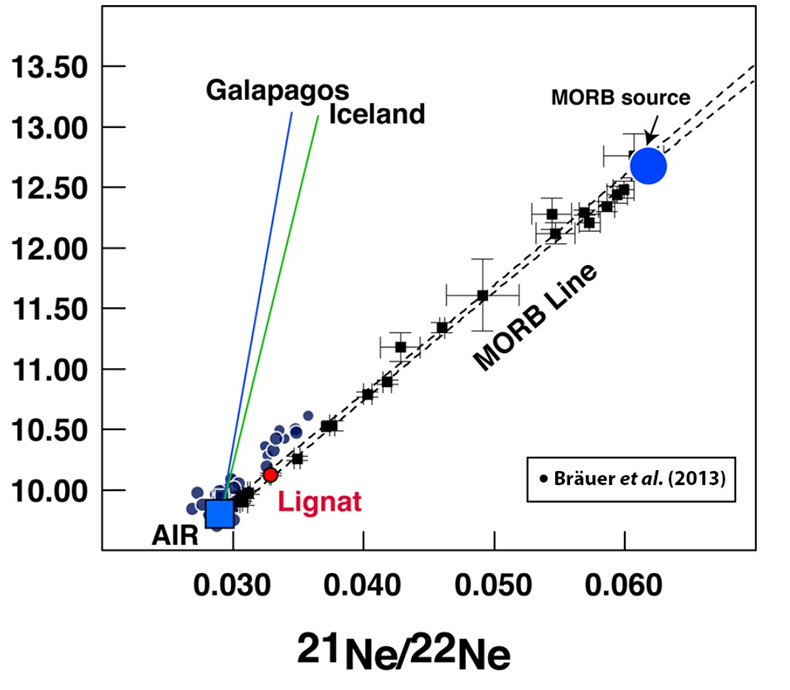
Figure 1 Three-neon isotope diagram. MORB data are from Moreira et al. (1998)
Moreira, M., Kunz, J., Allègre, C.J. (1998) Rare gas systematics on popping rock : estimates of isotopic and elemental compositions in the upper mantle. Science 279, 1178-1181.
and define the MORB-AIR mixing line (Sarda et al., 1988Sarda, P., Staudacher, T., Allègre, C.J. (1988) Neon isotopes in submarine basalts. Earth and Planetary Science Letters 91, 73-88.
), which has a different slope than the OIB mixing lines (Honda et al., 1991Honda, M., McDougall, I., Patterson, D.B., Doulgeris, A., Clague, D. (1991) Possible solar noble-gas component in Hawaiian basalts. Nature 349, 149-151.
; Moreira et al., 2001Moreira, M., Breddam, K., Curtice, J., Kurz, M. (2001) Solar neon in the Icelandic mantle: evidence for an undegassed lower mantle. Earth and Planetary Science Letters 185.
). The OIB mixing lines are from Mukhopadhyay (2012)Mukhopadhyay, S. (2012) Early differentiation and volatile accretion recorded in deep mantle Neon and Xenon. Nature 486, 101-104.
and Peron et al. (2016)Peron, S., Moreira, M., Colin, A., Arbaret, L., Putlitz, B., Kurz, M.D. (2016) Neon isotopic composition of the mantle constrained by single vesicles analyses. Earth and Planetary Science Letters 449, 145–154.
. The MORB source has a 20Ne/22Ne ~12.5. The neon in Lignat spring comes from the mixture of mantle-derived (~12 %) and atmospheric neon (~88 %). Data from the Eifel area are also reported (Brauer et al., 2013Brauer, K., Kampf, H., Niedermann, S., Strauch, G. (2013) Indications for the existence of different magmatic reservoirs beneath the Eifel area (Germany): A multi-isotope (C, N, He, Ne, Ar) approach. Chemical Geology 356, 193-208.
).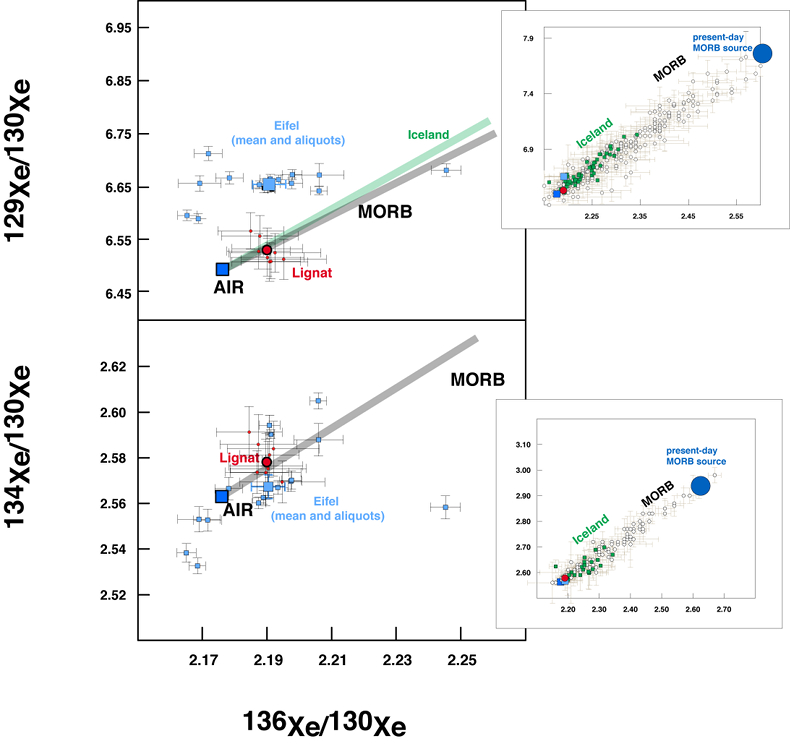
Figure 2 Xenon isotopes in the Lignat gas (aliquots: small red dots; mean: large red dot), compared to MORB (Kunz et al., 1998
Kunz, J., Staudacher, T., Allègre, C.J. (1998) Plutonium-Fission Xenon Found in Earth's Mantle. Science 280, 877-880.
; Parai et al., 2012Parai, R., Mukhopadhyay, S., Standish, J.J. (2012) Heterogeneous upper mantle Ne,Ar and Xe isotopic compositions and a possible Dupal noble gas signature recorded in basalts from the Southwest Indian Ridge. Earth and Planetary Science Letters 359-360, 227-239.
; Tucker et al., 2012Tucker, J.M., Mukhopadhyay, S., Schilling, J.-G. (2012) The heavy noble gas composition of the depleted MORB mantle (DMM) and its implications for the preservation of heterogeneities in the mantle. Earth and Planetary Science Letters 355-356, 244-254.
) and Iceland basalts (Mukhopadhyay, 2012Mukhopadhyay, S. (2012) Early differentiation and volatile accretion recorded in deep mantle Neon and Xenon. Nature 486, 101-104.
). The Eifel gas is shown for comparison (small blue squares: aliquots, large blue square: mean) (Caracausi et al., 2016Caracausi, A., Avice, G., Burnard, P., Furi, E., Marty, B. (2016) Chondritic xenon in the Earth’s mantle. Nature 533, 82-85.
). The inserts represent the global scale of variation in mantle-derived samples.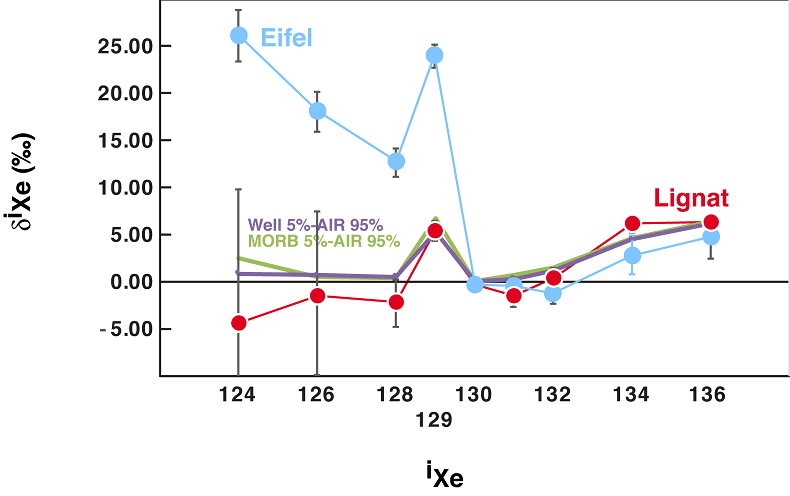
Figure 3 Xenon isotopic ratios in the Lignat gas expressed in ‰ deviation relative to the atmospheric composition. Assuming the xenon composition reflects mixing between air and MORB (or CO2-well gas; Holland and Ballentine, 2006
Holland, G., Ballentine, C.J. (2006) Seawater subduction controls the heavy noble gas composition of the mantle. Nature 441, 186-191.
), one can estimate the proportion of atmospheric xenon. Using the 136Xe/130Xe ratio, 95 % of the 130Xe in the Lignat source is sourced from the air. The other isotopic ratios can be estimated using this mixing proportion. Two patterns are given for the result of this mixing: violet using CO2-well gas and green using the mean MORB-source ratios (Table S-2). The Lignat gas satisfies a simple binary mixture between air and MORB. Although the Eifel gas (blue circles) shows the same pattern for fissiogenic isotopes, it exhibits notable excesses in light Xe isotopes that are unaccounted for by the MORB-AIR mixing model.





